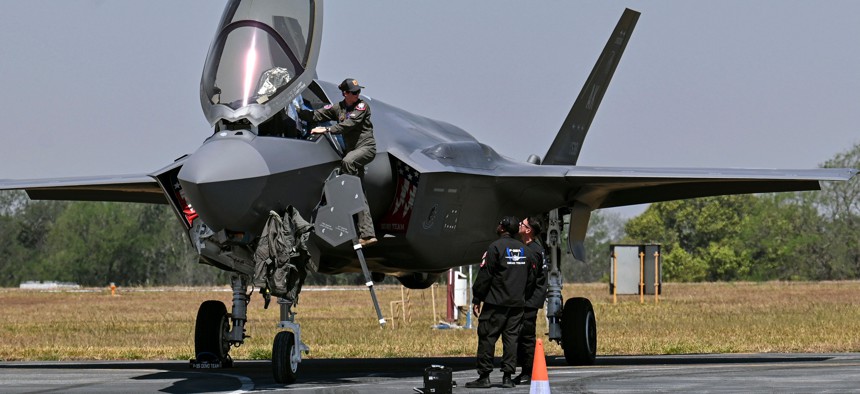
A pilot climbs into the cockpit of a U.S. Air Force F-35 fighter jet at the Aero India 2023 show in Bengaluru on February 14, 2023. Manjunath KIRAN/AFP via Getty Images
Air Force Wants More Planes Faster—Plus a Thousand Drone Wingmen
The service secretary previewed the 2024 budget request.
Updated: March 7, 4:08 p.m.
The U.S. Air Force wants to accelerate its purchases of existing aircraft—and wants a thousand drones to accompany its fighter pilots into combat, the service’s secretary said Tuesday.
“We will be acquiring aircraft in production at higher rates than previously planned,” Air Force Secretary Frank Kendall said Tuesday at an Air Force Association conference in Aurora, Colorado.
Those changes will be laid out in the Pentagon’s 2024 budget request, which will also contain close to 20 new programs or “significantly enhanced efforts,” Kendall said. The service will also propose the retirement of aircraft as part of its bid to increase “midterm capability and capacity,” he said.
The request is expected to be sent to Congress in coming days.
Kendall also outlined the service’s plans for “collaborative combat aircraft” – drones that will fly alongside manned fighters. The service is planning to buy 1,000 CCAs: 300 F-35s will get two drones apiece, as will 200 of the planned Next Generation Air Dominance, or NGAD, aircraft.
“This isn't an inventory objective, but a planning assumption to use for analysis of things such as basing organizational structures, training and range requirements and sustainment concepts,” he said, stressing that CCAs won’t reduce the planned inventory of crewed fighters.
Kendall told reporters that the number is “somewhat arbitrary” and the ratio of wingman-drones to manned fighters might change after testing.
The upcoming budget request will purchase “some assets” for experiments that will help the service develop operational concepts and reduce risk for the program.
Kendall added that the drones are part of an effort to reduce the cost of the future force; he said that if the service only purchases current aircraft in production—such as the F-35, F-15EX, and NGAD—“we’ll have an unaffordable Air Force.”
The NGAD is a new sixth-generation fighter jet that’s being developed in secret. The Air Force acknowledges the program exists, but will not say the contractor or contractors that are building the aircraft.
As the Pentagon continues to mature its Space arm, Kendall added that its 2024 budget will include funding to fulfill all of the Space Force’s requirements.
The production increases and the need to modernize the Air Force’s fleet are needed to keep pace with China, Kendall said. On Monday, the Air Force acquisition chief Andrew Hunter said the service would accelerate plans to buy a next-generation aerial tanker because of “threats that are posed by potential adversaries to high-value aircraft, including tankers.”
Kendall encouraged Congress to pass the Pentagon’s budget request before the fiscal year ends on Sept. 30.
“My greatest fear today is a delay or even worse, a failure to provide the Department of the Air Force and the Department of Defense with timely authorizations and appropriations,” Kendall said. “That will be a gift to China. It's a gift that we cannot afford.”




